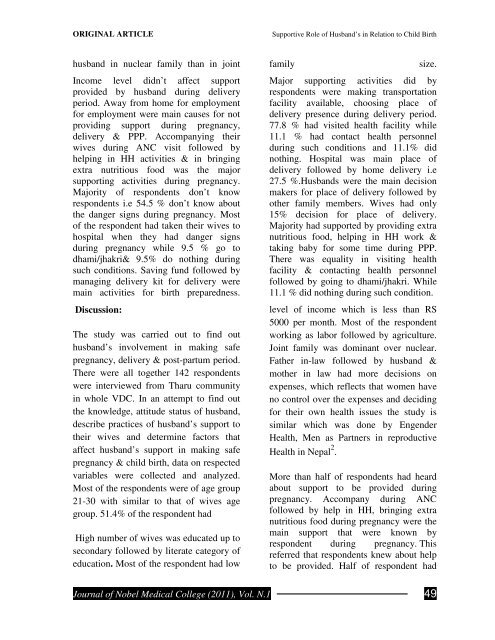Journal of - Nobel Medical College
Journal of - Nobel Medical College
Journal of - Nobel Medical College
You also want an ePaper? Increase the reach of your titles
YUMPU automatically turns print PDFs into web optimized ePapers that Google loves.
ORIGINAL ARTICLESupportive Role <strong>of</strong> Husband’s in Relation to Child Birthhusband in nuclear family than in joint family size.Income level didn’t affect supportprovided by husband during deliveryperiod. Away from home for employmentfor employment were main causes for notproviding support during pregnancy,delivery & PPP. Accompanying theirwives during ANC visit followed byhelping in HH activities & in bringingextra nutritious food was the majorsupporting activities during pregnancy.Majority <strong>of</strong> respondents don’t knowrespondents i.e 54.5 % don’t know aboutthe danger signs during pregnancy. Most<strong>of</strong> the respondent had taken their wives tohospital when they had danger signsduring pregnancy while 9.5 % go todhami/jhakri& 9.5% do nothing duringsuch conditions. Saving fund followed bymanaging delivery kit for delivery weremain activities for birth preparedness.Discussion:The study was carried out to find outhusband’s involvement in making safepregnancy, delivery & post-partum period.There were all together 142 respondentswere interviewed from Tharu communityin whole VDC. In an attempt to find outthe knowledge, attitude status <strong>of</strong> husband,describe practices <strong>of</strong> husband’s support totheir wives and determine factors thataffect husband’s support in making safepregnancy & child birth, data on respectedvariables were collected and analyzed.Most <strong>of</strong> the respondents were <strong>of</strong> age group21-30 with similar to that <strong>of</strong> wives agegroup. 51.4% <strong>of</strong> the respondent hadHigh number <strong>of</strong> wives was educated up tosecondary followed by literate category <strong>of</strong>education. Most <strong>of</strong> the respondent had lowMajor supporting activities did byrespondents were making transportationfacility available, choosing place <strong>of</strong>delivery presence during delivery period.77.8 % had visited health facility while11.1 % had contact health personnelduring such conditions and 11.1% didnothing. Hospital was main place <strong>of</strong>delivery followed by home delivery i.e27.5 %.Husbands were the main decisionmakers for place <strong>of</strong> delivery followed byother family members. Wives had only15% decision for place <strong>of</strong> delivery.Majority had supported by providing extranutritious food, helping in HH work &taking baby for some time during PPP.There was equality in visiting healthfacility & contacting health personnelfollowed by going to dhami/jhakri. While11.1 % did nothing during such condition.level <strong>of</strong> income which is less than RS5000 per month. Most <strong>of</strong> the respondentworking as labor followed by agriculture.Joint family was dominant over nuclear.Father in-law followed by husband &mother in law had more decisions onexpenses, which reflects that women haveno control over the expenses and decidingfor their own health issues the study issimilar which was done by EngenderHealth, Men as Partners in reproductiveHealth in Nepal 2 .More than half <strong>of</strong> respondents had heardabout support to be provided duringpregnancy. Accompany during ANCfollowed by help in HH, bringing extranutritious food during pregnancy were themain support that were known byrespondent during pregnancy. Thisreferred that respondents knew about helpto be provided. Half <strong>of</strong> respondent had<strong>Journal</strong> <strong>of</strong> <strong>Nobel</strong> <strong>Medical</strong> <strong>College</strong> (2011), Vol. N.1 49


